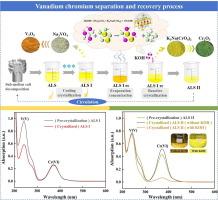Efficient recovery of valuable elements from oxygen-rich alkaline leaching solution of chrome-vanadium slag using selective crystallization separation process
IF 8.1
1区 工程技术
Q1 ENGINEERING, CHEMICAL
引用次数: 0
Abstract
A method for separating vanadium (V) and chromium (Cr) was studied to effectively process the alkaline leaching solution (ALS) obtained during the oxygen-rich leaching of V-Cr slag based on the sub-molten salt vanadium chromium co-extraction production process. The cooling crystallization experiments showed that with the conditions of OH– concentration of 8.75 mol/L, final temperature of 40℃, etc., the yield of vanadate reached over 63 %, indicating that Na3VO4 could be separated effectively by cooling crystallization in the low alkalinity region. Na3VO4 was further recovered as V2O5 product with a purity of 98.58 %. To address the low recovery efficiency of Na2CrO4 in previous studies, a novel approach of evaporation concentration combined with KOH addition was proposed. This method utilized double salt reaction crystallization to generate K3Na(CrO4)2 with lower solubility, thereby facilitating efficient separation and recovery of chromium. With the conditions of 16.25 mol/L OH–, n (KOH)/n (NaOH) = 0.3, etc., the yield of chromate increased from 20 % to over 88 %. K3Na(CrO4)2 was eventually recovered as Cr2O3 by reduction precipitation with a purity of 98.67 %. The entire process successfully achieved separation and recovery of vanadium and chromium in the ALS, producing qualified vanadium chromium products with almost no wastewater discharge, providing a new strategy for the resource utilization of the ALS.

求助全文
约1分钟内获得全文
求助全文
来源期刊

Separation and Purification Technology
工程技术-工程:化工
CiteScore
14.00
自引率
12.80%
发文量
2347
审稿时长
43 days
期刊介绍:
Separation and Purification Technology is a premier journal committed to sharing innovative methods for separation and purification in chemical and environmental engineering, encompassing both homogeneous solutions and heterogeneous mixtures. Our scope includes the separation and/or purification of liquids, vapors, and gases, as well as carbon capture and separation techniques. However, it's important to note that methods solely intended for analytical purposes are not within the scope of the journal. Additionally, disciplines such as soil science, polymer science, and metallurgy fall outside the purview of Separation and Purification Technology. Join us in advancing the field of separation and purification methods for sustainable solutions in chemical and environmental engineering.
 求助内容:
求助内容: 应助结果提醒方式:
应助结果提醒方式:


